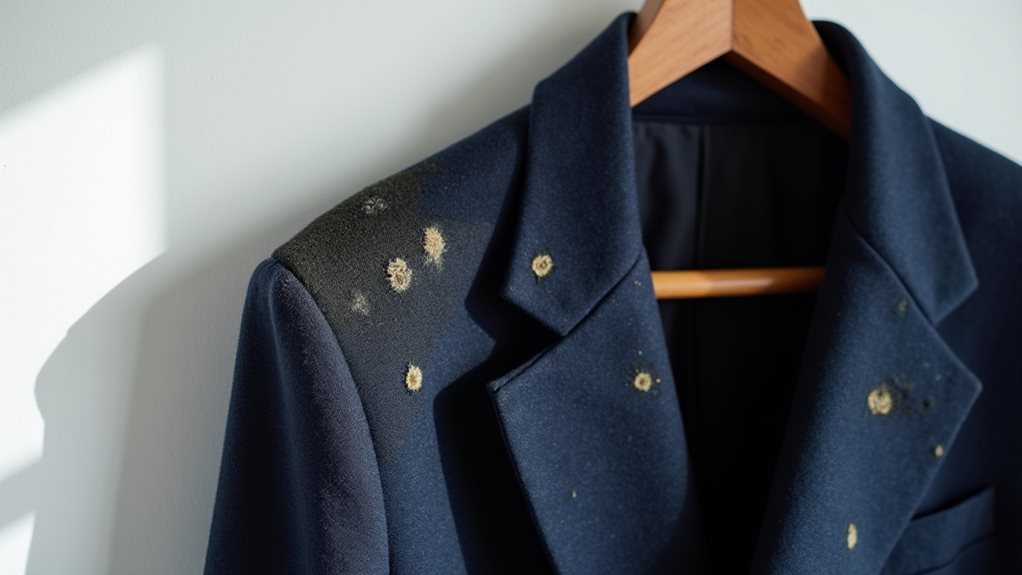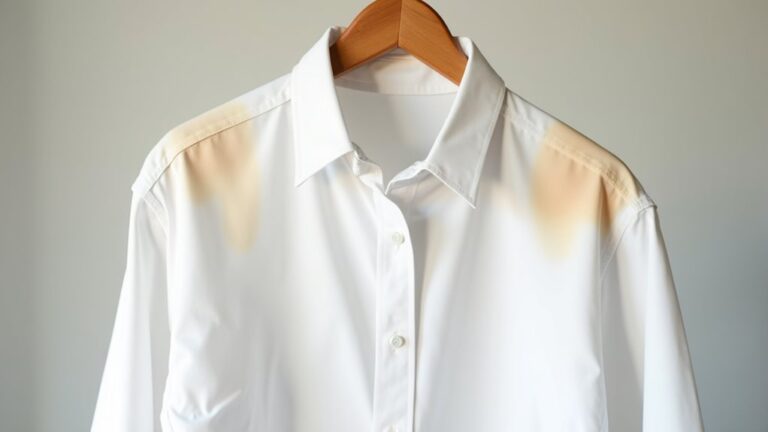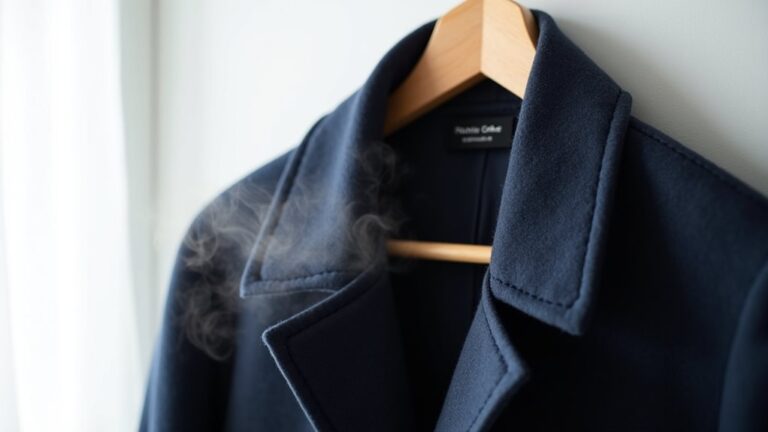Dry cleaning can absolutely tackle mildew on your clothes, thanks to powerful solvents like perchloroethylene that dissolve what water can’t touch. The high temperatures (around 140°F) during the process kill existing spores while protecting delicate fabrics – I’ve seen countless “hopeless” garments come back to life this way. However, success depends on how deeply those sneaky spores have embedded into the fibers, and you’ll want to explore additional strategies for the most stubborn cases.
Understanding How Mildew Forms on Textiles
The silent invader we call mildew has probably made an unwelcome appearance in your closet at least once, and trust me, I’ve learned the hard way that this sneaky fungus doesn’t need much of an invitation to set up shop on your favorite clothes.
Mildew doesn’t knock before moving in—this sneaky fungus treats your closet like an all-you-can-eat buffet of favorite fabrics.
This white, powdery menace thrives when moisture meets poor air circulation, transforming your stored textiles into its personal playground.
Whether it’s a damp basement, humid attic, or simply that pile of slightly-wet laundry you forgot about (we’ve all been there 😅), mildew spores keenly embed themselves deep into fabric fibers.
Without proper storage practices and adequate ventilation, even your most treasured garments become vulnerable, often requiring professional cleaning to fully eliminate the musty evidence of this unwelcome guest.
While dry cleaning’s chemical solvents can effectively tackle surface mildew and eliminate odors, deeply embedded spores in porous fabrics like wool and cotton may prove more challenging to completely eradicate.
The Science Behind Dry Cleaning Processes
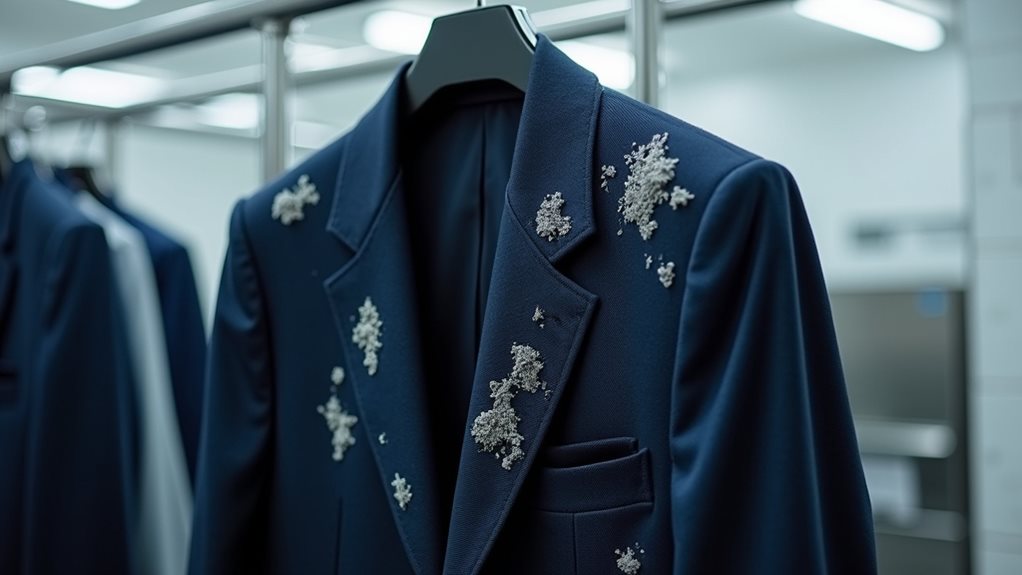
Solvents become the unsung heroes of fabric restoration when you understand how dry cleaning actually works, and I’ll admit, I was genuinely fascinated when I first learned that this process doesn’t involve a single drop of water.
Your professional dry cleaner uses powerful solvents like perchloroethylene that literally dissolve oils, greases, and those stubborn contaminants that water can’t touch – including mildew spores that make your clothes smell like a forgotten basement corner 😅.
The cleaning process combines these chemical powerhouses with gentle agitation and temperatures reaching 60-63°C, creating a perfect storm that can remove mould while protecting delicate fabrics.
It’s honestly impressive how solvents used in dry cleaning don’t just clean your garments but actually kill existing mildew, making this science-backed approach incredibly effective.
However, the effectiveness depends on factors such as the type of fabric, extent of mildew growth, and specific chemicals used, with deeply embedded mildew in porous materials sometimes requiring more intensive treatment methods.
Effectiveness of Dry Cleaning Against Mildew Spores
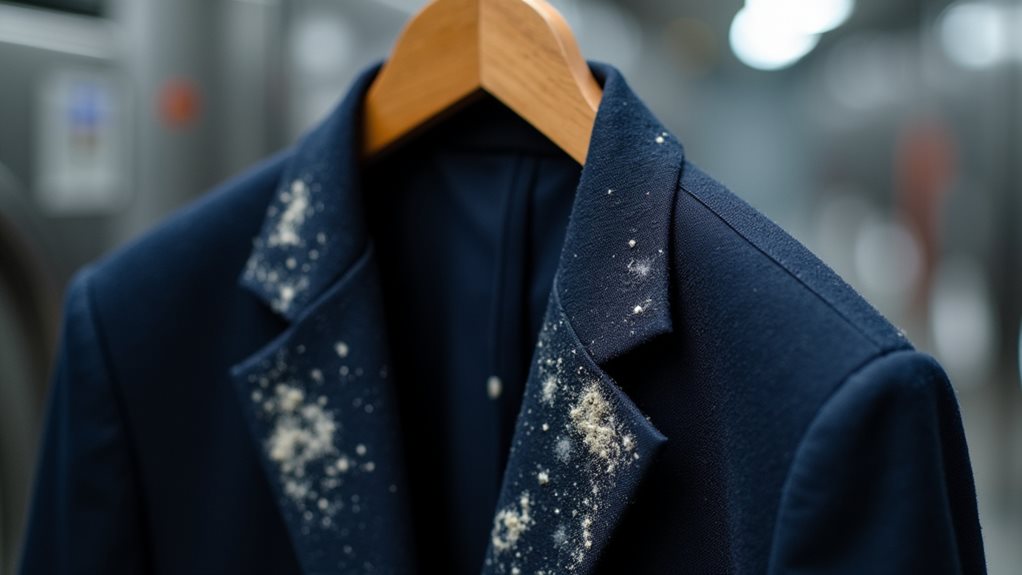
Now that we’ve explored the powerful chemistry at work, you’re probably wondering just how well this solvent-based approach actually performs against those pesky mildew spores that seem to cling to fabric like unwanted house guests.
The truth is, dry cleaning can remove a notable portion of mold spores, but it’s not always a complete knockout punch 💪.
Professional dry cleaners use high-temperature solvents that effectively kill most active spores, though success varies depending on fabric type and the severity of your mildew infestation.
Here’s where proper communication becomes essential – when you’re upfront about the issue, experienced cleaners can adjust their process for more effective cleaning, potentially saving your favorite garments from becoming expensive casualties.
However, some dry cleaners may refuse heavily contaminated items due to health concerns and the risk of cross-contamination with other customers’ clothing.
Pre-Treatment Methods for Heavily Affected Garments
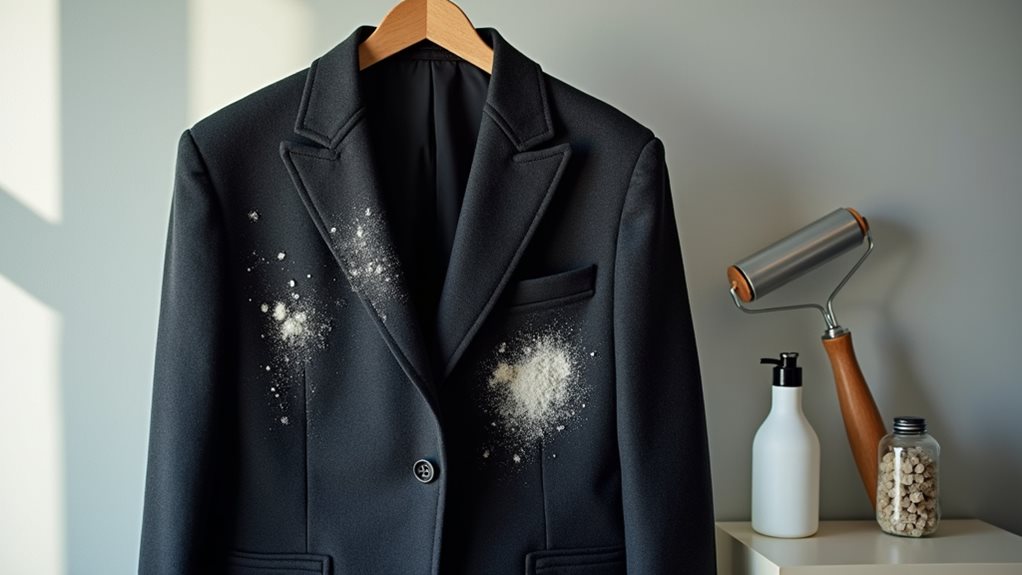
Start by inspecting each piece outdoors (trust me, you don’t want those spores floating around indoors).
Then apply targeted stain removers that break down mildew proteins. Oxygen bleach works wonders for killing spores and eliminating that musty smell.
Though deeply embedded mildew might require professional assessment for truly effective treatment. Communication with your dry cleaner about the extent of damage guarantees they’ll choose the most appropriate methods for your specific garments.
When discussing treatment options with your dry cleaner, ask about safer alternatives like wet cleaning or hydrocarbon solvents that reduce chemical exposure while still effectively treating mildew damage.
Professional vs. DIY Mildew Removal Approaches
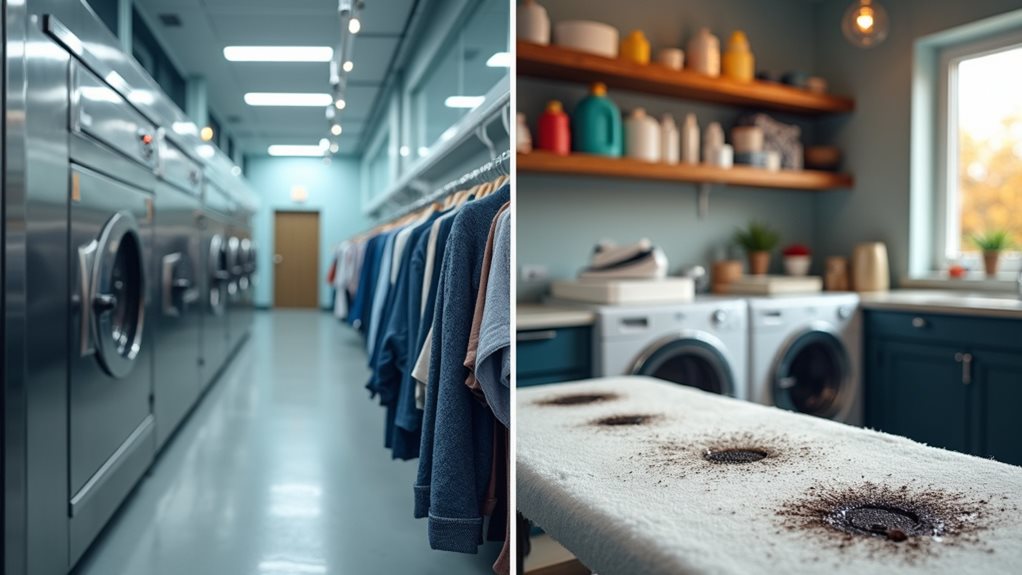
When you’re staring at that mildew-stained blazer you forgot in your gym bag for three weeks (we’ve all been there 😅), you’ll face a vital decision between rolling up your sleeves for a DIY battle or surrendering the garment to professional cleaners who actually know what they’re doing.
While your kitchen cabinet arsenal of vinegar and bleach might seem like budget-friendly heroes, they often lack the penetrating power and specialized knowledge that professional dry cleaners bring to the mildew-fighting arena.
The truth is, professionals don’t just throw your clothes in a fancy washing machine and hope for the best—they use targeted solvents, high-tech equipment like the Esporta Wash System, and years of experience to tackle even the most stubborn spores that laugh in the face of your home remedies.
However, it’s worth noting that traditional dry cleaning solvents like perchloroethylene (PERC) have been classified as probable carcinogens, so you may want to seek out eco-friendly cleaners that use safer alternatives when treating your mildew-damaged garments.
Professional Treatment Advantages
Although you might feel confident tackling that musty sweater with a bottle of white vinegar and some elbow grease, professional dry cleaning offers a level of mildew-fighting power that’s honestly hard to match in your laundry room.
Professional treatment brings specialized solvents used in dry cleaning that penetrate fabric fibers far deeper than traditional washing methods can reach, effectively eliminating even stubborn evidence of mold that’s been lurking for weeks.
Think of it this way: while your DIY approach might freshen up surface odors, professional mildew removal targets the root cause with high-temperature treatments and targeted pre-cleaning solutions.
These experts can assess your fabric’s condition, apply the right combination of solvents, and use advanced systems like the Esporta technology that safely decontaminates delicate items without causing additional damage.
The high heat exposure generated in commercial dry cleaning machines creates temperatures that are lethal to mildew and other microorganisms, making it a powerful tool for fabric restoration.
DIY Method Limitations
While many of us have that one friend who swears by their grandmother’s vinegar-and-baking-soda concoction for everything from stubborn stains to questionable odors, the reality is that DIY mildew removal methods often fall short when you’re dealing with anything beyond surface-level problems.
Sure, these DIY methods might tackle what you can see, but they’re like putting a band-aid on a broken bone when it comes to deep-seated mildew spores.
Professional cleaners can kill those stubborn spores hiding deep within fabric fibers, something your kitchen cabinet remedies simply can’t match.
Plus, DIY approaches often leave behind moisture, creating the perfect breeding ground for future mildew growth – talk about a frustrating cycle that’ll have you wanting to remove mold permanently! 😤
However, it’s worth noting that professional dry cleaning uses chemical solvents like perchloroethylene that can pose health risks, so proper airing out of treated garments is essential for safety.
Prevention Strategies After Dry Cleaning Treatment
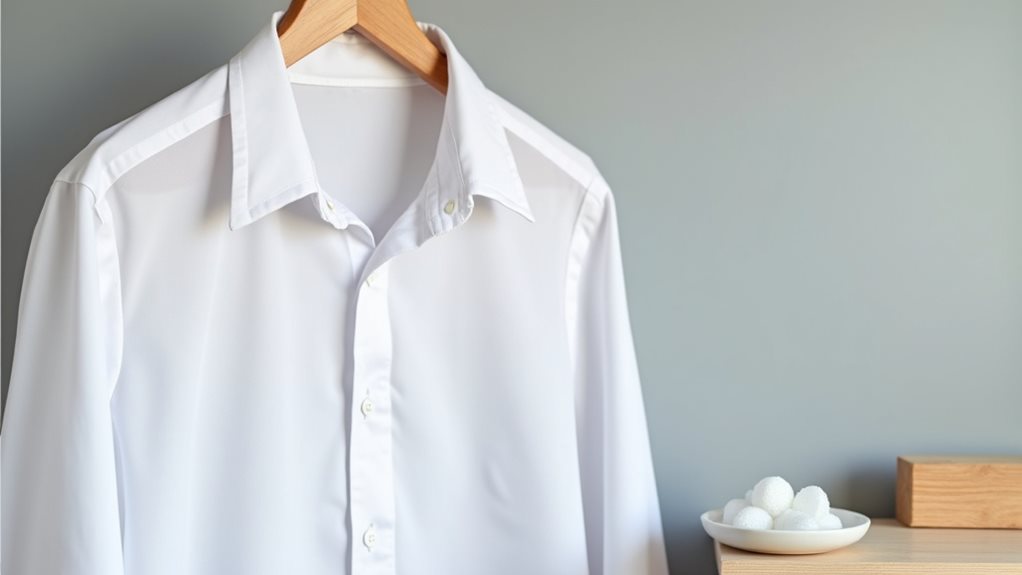
Even after your dry cleaner works their magic to eliminate existing mildew, you’ll want to become a bit of a storage detective to prevent those pesky spores from making a comeback.
Trust me, I’ve learned this lesson the hard way after rescuing a favorite blazer from mildew, only to watch it happen again because I rushed the storage process.
First, make sure your garments are properly dry before tucking them away – even professional dry cleaning can leave trace moisture that spores latch onto like tiny hitchhikers.
Even professionally cleaned clothes can harbor sneaky moisture that gives mildew spores the perfect opportunity to multiply and ruin your wardrobe.
Swap those plastic garment bags for breathable alternatives, give your clothes room to breathe in well-ventilated spaces, and toss in some silica gel packs for good measure.
Preventing mould becomes much easier when you’re proactive about airflow! 🌬️
Remember that excessive dry cleaning can actually damage your clothes over time through repeated chemical exposure, so balance professional treatment with proper preventive storage practices.

